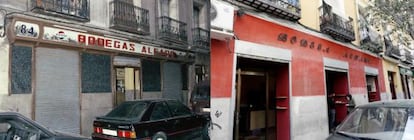Madrid’s vanishing historic store fronts
Hundreds of the capital’s listed shop exteriors and signs have been illegally removed or altered


Trying to juggle esthetics, town planning, cultural heritage, private property, making a living, and bureaucracy is a tough act, and one that will often lead to some pretty absurd outcomes. For example, in 1997, Madrid City Hall published a catalogue of around 1,500 historic store fronts and signage in the capital with the aim of protecting this unique aspect of the city’s commercial heritage. Even at the time, some had already gone, such as the former grocery store on the corner of Monteleón street in the Malasaña neighborhood; others supposedly protected by municipal legislation have since disappeared through accident or design.
A check of around 50 of the protected shop fronts reveals that almost half have been damaged, removed, or modified in some way. Some have been changed with the approval of City Hall, but still remain in its catalogue, such as those at 9 Fuentes street, or 62 Serrano street; some have been vandalized or fallen into disrepair following the closure of the premises, lost for ever. But above all, the problem seems to be that work has been carried out, or store fronts and signage have been removed, without the permission of the relevant authority, which is City Hall’s Agency for the Management and Opening of Economic Activities (AGLA).
At least that is what City Hall says. Furthermore, any changes to a listed building requires the permission of the capital’s two heritage commissions, which include a member of the capital’s College of Architects.

A bar on Princesa street, known only as “51” had its signage removed and is now a cellphone store; a former bookstore at 8 Plaza Santa Ana is now a restaurant, as is the former Bearnesa bakery at 82 Fuencarral street, while the Estanislao Rodríguez bookstore, at 27 San Bernado street, has been turned into a hairdressers. These are just a few examples of shop fronts that have been removed without the necessary permission, although no action has been taken against their owners.
City Hall says that in some cases, licenses were issued while the catalogue was being prepared, which might explain some anomalies.
But it doesn’t explain, for example, what happened to Bodegas Alfaro, on 84 Amparo street in the Lavapíes district, whose signage, dating back to 1911, was protected by law. Five years ago, a car parked in front of the bar was set alight, severely damaging the entrance. José Luis Rico, the owner of the bar, which was formerly run by his father, says he wanted to rebuild the frontage, but City Hall wouldn’t let him, meaning that he had to leave the exposed stone that lay underneath the shop front paneling. Inside, the bar retains many of its original features.
Vicente Patón, an architect and member of the heritage commission, describes City Hall’s policies as a disaster: “Somebody buys a premises, changes it completely, even though it is listed, and nothing happens. It’s a shame. We are destroying the city’s heritage, and nobody gives a damn.”
Javier González of the Madrid College of Architects says there seem to be no clear guidelines as to why some store fronts are worth protecting and others not. “There are some very old signs that are not really of any value, and there are some more contemporary ones that should be looked after,” he says, asking: “Who decides these things? It’s all very subjective.”

One reason why many storekeepers might choose to remove historical signage without asking permission is because doing so can be a very costly and time-consuming process.
Ask the owners of 16 Ribera de Curtidores, the hill in the city’s Latina district that hosts the Rastro flea market each Sunday. Blas de la Fuente bought the premises in 1999; the façade was as it is at present, while the interior was empty. Since then he has applied for planning permission five times (each application costing €5,000) to refurbish the premises, protecting whatever needs to be protected, and that each time, his application has been denied. “The problem is that they don’t know what was originally here: there are some references to a counter, some beams, but they don’t know,” he says. City Hall says that no license has been granted and that work undertaken to the premises has been noted as not complying with municipal ordinances. De la Fuente says he has even considered giving the property away.
González says that perhaps it would make sense for City Hall to produce a shorter list, and be more stringent about protecting the buildings on it. He thinks that upcoming legislation would make it much easier for owners to undertake work and remove historic store fronts.
Patón says that between 2005 and 2007, when the catalogue was updated, several hundred store fronts had disappeared. He fears that many more will have gone by now, making City Hall’s catalogue ever thinner, when it is finally updated.







































